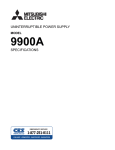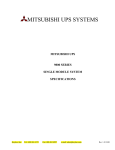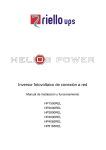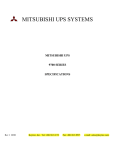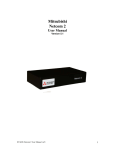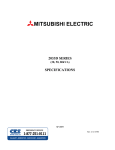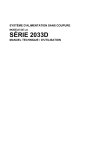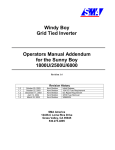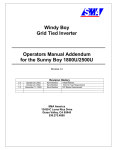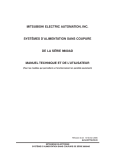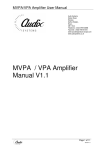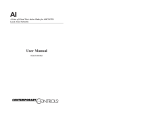Download Mitsubishi 9800A Series Specifications
Transcript
UNINTERRUPTIBLE POWER SUPPLY MODEL 9800AE SINGLE MODULE SYSTEM SPECIFICATIONS TABLE OF CONTENTS PART 1 GENERAL .........................................................................................................................2 1.1 SUMMARY ............................................................................................................................2 1.2 STANDARD ...........................................................................................................................2 1.3 SYSTEM DESCRIPTION ......................................................................................................2 1.3.1 Components ......................................................................................................................2 1.3.2 Mode of Operation.............................................................................................................2 1.4 SUBMITTALS ........................................................................................................................3 1.4.1 Proposal Submittals ..........................................................................................................3 1.4.2 Delivery Submittals............................................................................................................3 1.5 ENVIRONMENTAL CONDITIONS ........................................................................................4 1.6 WARRANTY ..........................................................................................................................4 1.7 QUALITY ASSURANCE ........................................................................................................4 1.7.1 Reliability ...........................................................................................................................4 1.7.2 Maintainability....................................................................................................................5 1.7.3 Factory Test .......................................................................................................................5 PART 2 PRODUCT.........................................................................................................................5 2.1 ELECTRIC CHARACTERISTICS..........................................................................................5 2.1.1 UPS Output Capacity ........................................................................................................5 2.1.2 Battery Capacity ................................................................................................................5 2.1.3 AC Input.............................................................................................................................6 2.1.4 Bypass Input......................................................................................................................6 2.1.5 AC output...........................................................................................................................6 2.1.6 DC input and Battery .........................................................................................................7 2.1.7 Efficiency ...........................................................................................................................7 2.2 COMPONENTS .....................................................................................................................7 2.2.1 Hybrid Converter Section: .................................................................................................7 2.2.2 Inverter ..............................................................................................................................10 2.2.3 UPS Module Control and Monitoring ................................................................................12 2.2.4 Bypass and Static Switch ..................................................................................................13 2.2.5 Operation/Display Panel ...................................................................................................14 2.2.6 Microprocessor Interface/Diagnostics...............................................................................16 2.2.7 UPS Status and Function Interfacing ................................................................................17 2.2.8 (Option) Remote Status Alarm Panel ................................................................................18 2.2.9 (Option) DiamondSync ......................................................................................................18 2.2.10 (Option) Common Battery .................................................................................................18 2.3 MECHANICAL DESIGN ........................................................................................................18 2.3.1 Cabinet Structure (Enclosure) ...........................................................................................18 2.3.2 Serviceability .....................................................................................................................19 2.3.3 Ventilation ..........................................................................................................................19 2.3.4 Busbar ...............................................................................................................................19 2.3.5 (Option) Eyebolts...............................................................................................................19 PART 3 3.1 3.2 3.3 EXECUTION` ....................................................................................................................19 SITE PREPARATION ............................................................................................................19 INSTALLATION .....................................................................................................................19 FIELD QUALITY CONTROL..................................................................................................19 98AEtypSMSspec_RevC.doc 1 Copyright © 2007, Mitsubishi Electric Power Products, Inc. SP-0012 Rev. C 09/05/09 SECTION 16610 STATIC UNINTERRUPTIBLE POWER SUPPLY SYSTEM PART 1 GENERAL 1.1 SUMMARY This specification describes a three phase continuous duty, an on-line, solid-state, uninterruptible power system, hereinafter referred to as the UPS. The UPS shall operate utilizing the existing power distribution system to provide a high quality, reserve source of power to electronic equipment loads. The system shall consist of a rectifier, system battery, solid-state inverter, automatic static bypass transfer circuit and integral maintenance bypass circuit. 1.2 STANDARD The UPS has been designed in accordance with and complies with the following standards; 1. 2. 3. 4. 5. UL 1778 (Underwriter Laboratories) Standard for UPS Equipment. CSA 22.2 (Canadian Standards Association – cUL Equipment). IEC (International Electro-technical Commission) Semiconductor Converter Standards. IEEE 587, ANSI C62.41 1980 Standard for Surge Withstand Ability. ISO 9001 Quality Assurance program. 1.3 SYSTEM DESCRIPTION 1.3.1 Components The UPS system shall consist of the following major equipment; A. UPS module. 1. Insulated Gate Bipolar Transistor (IGBT) Inverter. 2. Diode Bridge + IGBT DC/DC Rectifier. 3. Digital Signal Processor (DSP) using Pulse Width Modulation (PWM) for Direct Digital Control (DDC) of all UPS control and monitoring functions. 4. Static bypass switch sized to provide fault clearing. 5. 65KA withstand rating (option) B. Battery system. C. Battery protective and disconnect device. D. Maintenance bypass switch (option). E. Remote status alarm panel (option). 1.3.2 Mode of Operation The UPS shall be designed to operate continuously at rated capacity as an on-line, automatic reverse transfer system in the following modes; A. Normal - The inverter continuously supplies AC power to the critical load. The rectifier converts a utility AC power source to regulated DC power which then serves as the inverter input and, simultaneously, as a float charge input to the storage battery. B. Emergency - In the event of a utility AC power failure, the inverter shall derive its input from the system battery, therefore providing uninterrupted power to the critical load. 98AEtypSMSspec_RevC.doc 2 Copyright © 2007, Mitsubishi Electric Power Products, Inc. SP-0012 Rev. C 09/05/09 This transition shall be accomplished without any switching or coupling, and with no interruption of power to the critical load from either a failure or restoration of the utility AC power. C. Recharge - Subsequent to restoration of utility AC power, the rectifier shall automatically reactivate and provide DC power to the inverter, simultaneously recharging the system battery. This occurs automatically and without interruption to the critical load. D. Bypass - In the event that the UPS must be taken off line due to an overload condition or UPS failure, the critical load shall be transferred to the bypass source via the static switch without interruption of AC power to the critical load. A paralleling, wrap-around contactor shall be used to maintain the bypass source. The static switch shall only be utilized for automatic emergency transfers. A re-transfer from bypass to inverter shall be performed automatically in overload conditions. A re-transfer shall be inhibited if satisfactory synchronization of the inverter and bypass is not accomplished. The use of the static switch shall not be required during the manual or automatic re-transfer process, therefore increasing reliability. E. Maintenance Bypass – The UPS system shall be equipped with an external MBS to allow safe and reliable maintenance of the UPS. The MBS shall be of the Make-Before-Break, “Zero Energy” type to ensure maximum load reliability and personnel safety. 1.4 SUBMITTALS 1.4.1 Proposal Submittals Submittals with the proposal shall include; A. System configuration with single-line drawings. B. Functional relationship of equipment including weights, dimensions, and heat dissipation. C. Descriptions of equipment to be furnished, including deviations from these specifications. D. Size and weight of shipping units to be handled by installing contractors. E. Detailed layout of customer power and control connections. F. Detailed installation drawings including all terminal locations 1.4.2 Delivery Submittals Submittals upon UPS delivery shall include; A. Shop Drawings. Submit system configurations with single line diagrams, detailed layout of power and control connections, dimensional data and detailed installation drawings including all terminal locations. B. Product Data. Provide product data for UPS and battery including catalog sheets and technical data sheets to indicate electrical performance, UPS type, battery type, detailed equipment outlines, weight, dimensions, control and external wiring requirements, heat rejection and air flow requirements. C. Owners and technical manual (1). D. Test Report 98AEtypSMSspec_RevC.doc 3 Copyright © 2007, Mitsubishi Electric Power Products, Inc. SP-0012 Rev. C 09/05/09 Submit a copy of factory and field test reports. 1.5 ENVIRONMENTAL CONDITIONS A. The UPS shall be capable of withstanding any combination of the following external environment conditions without mechanical damage, electrical failure or degradation of operating characteristics. 1. Operating ambient temperature: 0 degrees C to +40 degrees C (32 degrees F to 104 degrees F) no derating required. 2. Recommended operating temperature range: +20 degrees C to +30 degrees C (68 degrees F to 86 degrees F). 3. Non-operating and storage ambient temperature: -20 degrees C to +70 degrees C (-4 degrees. F to 158 degrees F). 4. Operating relative humidity: 5% to 95%, non-condensing. 5. Recommended operating relative humidity: 30% to 90%. 6. Operating altitude: Sea level to 2700 meter (9000ft). 7. There should be no inflammable / explosive gas. 8. Dust in the room where the UPS is installed must not exceed normal atmospheric dust levels. In particular, that dust should not include iron particles, oils or fats, or organic materials such as silicone. B. Audible acoustical noise: Noise generated by the UPS, when operating under full rated load, at a distance of one meter from any UPS operator surface, shall not exceed ___ dB as measured on the A scale of a standard sound level meter at slow response. C. Input surge withstand capability: The UPS shall be in compliance with IEEE C62.41, Category B. 1.6 WARRANTY The UPS manufacture shall warrant to the original end user that the Uninterruptible Power Supply System sold by Mitsubishi Electric Power Products, Inc. (the “Product”) shall be free from defects in material and workmanship under normal use and service for a period of twenty four (24) months from the date of installation or thirty months (30) months from the date of shipment of the Product, whichever comes first, at the premises of the original end user. 1.7 QUALITY ASSURANCE 1.7.1 Reliability The UPS equipment reliability shall be represented in terms of theoretical Mean-Time-Between-Failures (MTBF). The UPS manufacturer shall, as a minimum, provide the following capability: A. Total single module UPS system output (includes reliability of bypass circuit): 1,000,000 MTBF hours. B. Single module UPS operation (represents UPS module operation only): 120,000 MTBF hours. 98AEtypSMSspec_RevC.doc 4 Copyright © 2007, Mitsubishi Electric Power Products, Inc. SP-0012 Rev. C 09/05/09 1.7.2 Maintainability MTTR of the UPS shall not exceed 1 hour including time to replace components. 1.7.3 Factory Test A. The manufacturer shall fully and completely test the system to assure compliance with the specifications, before shipment. B. All UPS units shall come equipped with one (1) factory test report included in the UPS enclosure. The factory test report shall include the following: 1. 2. 3. 4. 5. 6. 7. 8. 9. 10. 11. 12. 13. Series / kVA Serial Number Date of test Approved by / Inspected by / Tested by Inspection of construction Checking of wiring (Black/Red marking on each connection point) Grounding Continuity Insulation strength test Control Circuit Operation Measurement of steady state characteristics (Voltage/ current/ efficiencies) Transient characteristics (0-100% step load, without batteries/ voltage fluctuation) Overload Testing Transfer switch operation PART 2 PRODUCT 2.1 ELECTRIC CHARACTERISTICS The UPS shall have the following electrical characteristics; 2.1.1 UPS Output Capacity The 9800A Series UPS Module is available in the following sizes: kVA 100 150 225 300 375 500 750 kW 80 120 180 270 337.5 450 675 UPS Module output capacities are in accordance with the following power factors: A. 100 kVA ~ 225 kVA B. 300 kVA ~ 750 kVA 2.1.2 0.8 pf lagging 0.9 pf lagging Battery Capacity A. Discharge time to end voltage: 98AEtypSMSspec_RevC.doc ___ minutes at full load, 25 degrees C (77 degrees F). 5 Copyright © 2007, Mitsubishi Electric Power Products, Inc. SP-0012 Rev. C 09/05/09 2.1.3 AC Input A. B. C. D. E. F. Nominal input voltage: 480V. Number of phase: 3 phase, 3 wire, plus ground. Voltage range: +15%, -15%. Frequency and range: 60Hz +/-5%. Power walk-in time: 10 seconds (0% to 100% load). Power factor: 1. 0.98 leading typical at 100% load. 2. 0.90 leading typical at 50% load. G. Reflected input current total harmonic distortion (THD): 1. 6% typical at 100% load. 2. 9% typical at 50% load. 2.1.4 Bypass Input A. B. C. D. 2.1.5 Nominal input voltage: 480V, 600V. Number of phase: 3 phase, 4 wire. Synchronization voltage range: +/-10% of nominal. Frequency tracking range: 60Hz +/-5% Maximum. (Bypass synchronous range shall be selectable from 1% to 5% in 1% increment) AC output A. B. C. D. E. F. G. H. I. J. K. L. Nominal output voltage: 480V/277V, 600V/346V. Number of phase: 3 phase, 4 wire, plus ground. Nominal dynamic Voltage regulation: +/-1% for unbalanced load. Manually adjustable output voltage: +/-5% range. Voltage transient response: 1. 100% step load: +/-2%. 2. Loss or return of AC input: +/-1%. 3. Retransfer from bypass to inverter: +/-5% (Voltage transient response shall not exceed the above and shall recover to within nominal voltage regulation tolerance within 16.7 msec.) Frequency (inverter synchronous): 60 Hz (tracks frequency of static bypass source). Free running output frequency (on battery or asynchronous): 60 Hz +/- 0.05%. Frequency slew rate (inverter synchronized to static bypass): 1Hz to 10Hz/second (selectable). Output voltage harmonic distortion: 1. 2% maximum at 100% linear load. 2. 5 % maximum at 100% non-linear load. (Load power factor range of 0.7 lagging to 1.0 within kW rating of UPS.) Voltage phase angle displacement: 1. +/-1 degree for 100% balanced load. 2. +/-3 degree for 100% unbalanced load. Overload capability: 1. 105% to 125% for 10 minutes (Voltage regulation maintained). 2. 125% to 150% for 1 minute (Voltage regulation maintained). Fault clearing: Typically 500% for 1 cycle (utilizing bypass source). 1. Typically 1000% for 1 cycle (utilizing bypass source) (100kVA to 225kVA) 2. Typically 500% for 1 cycle (utilizing bypass source) (300kVA to 750kVA) 98AEtypSMSspec_RevC.doc 6 Copyright © 2007, Mitsubishi Electric Power Products, Inc. SP-0012 Rev. C 09/05/09 2.1.6 DC input and Battery 1. 2. Voltage: 480V DC nominal, 400V DC minimum. Voltage ripple (normal operation): less than 2% of DC voltage. A. The Battery System shall be sized to provide the specified back-up time to the inverter when the UPS is supplying 100% rated load. B. Each Battery System shall include a disconnect 600V DC circuit breaker to facilitate isolation of UPS Module DC Input and the Battery System. The DC Circuit breaker shall incorporate an UVT relay and auxiliary contact connections to the UPS Module control for prevention of incorrect start up and shutdown sequencing. C. The battery system shall be capable of operating in an average ambient temperature of 25°C, with excursions of 16°C to 32°C and shall be sized as follows: Float Voltage: 545V DC (2.25 to 2.27 V/cell) Final Voltage: 400V DC (1.67 V/cell) 2.1.7 Efficiency UPS Module Capacity (kVA) 100 150 225 300 375 500 750 Battery to AC (100% Load) 0.935 0.935 0.930 0.935 0.935 0.940 0.940 AC to AC (100% Load) 0.935 0.935 0.930 0.935 0.935 0.940 0.940 2.2 COMPONENTS UPS module shall be comprised of the following; 2.2.1 Hybrid Converter Section: AC input, converter input contactor, converter input fuse, input harmonic filter, and hybrid converter utilizing; 2.2.1.1 High Power Diode Bridge Rectifier A. General A high power diode bridge rectifier converts the utility AC input power into regulated DC power that serves as the inverter input and also as dc charge power to the system battery through the chopper/booster. An AC reactor and capacitor shall filter the harmonic content of rectifier input. B. Reflected Harmonic Content The high power diode bridge rectifier shall typically not introduce more than 6% reflected 98AEtypSMSspec_RevC.doc 7 Copyright © 2007, Mitsubishi Electric Power Products, Inc. SP-0012 Rev. C 09/05/09 input current total harmonic distortion (THD) into the utility AC input source at nominal voltage and rated load. The reflected input current shall typically not exceed 9% THD at 50 % load. C. Automatic Input Power Walk-in The rectifier logic and control circuit power walk in function enables delayed and timed ramping of input current. Subsequent to energizing the rectifier input, initiation of the power walk in function and current ramping shall be delayed by a maximum of 3600 seconds (every 1 second adjustable – default at 10 second). Upon initiation of the power walk-in function, the ramping of current shall be timed to gradually increase the load within 10 seconds. This function is included as standard in the rectifier control circuitry. D. Input Overcurrent Protection Converter input contactor, input fuses, and the input current limit control shall provide rectifier protection against excessive input overload conditions. E. Step Load Change Operation (0-100%) In the occurrence of a 100% step load change, the UPS Module inverter shall draw power only from the rectifier to provide the required load demand. The charger/booster shall not be utilized and the system batteries will not be cycled at any time during a step load change. 2.2.1.2 Charger/Booster A. General The charger/booster utilizes solid state Pulse Width Modulation (PWM) controlled Insulated Gate Bipolar Transistors (IGBT). The charger switching frequency is 10kHz, and the booster switching frequency 2kHz. B. Battery Charge Current Limit The charger logic and control circuit DC battery current limiting function enables controlled battery charging. The battery charge current limit will control the recharge current by reducing the rectifier/charger output when the set limit is reached. The following battery current limit shall be provided as a minimum: 1. 2. Battery charge current limit: 10% of battery Ah rate. Maximum charge current: 13% ampere of UPS rated kVA. (e.g. 13ADC maximum of 100kVA UPS) C. Equalize Charge Timer UPS Module logic and control shall provide an electronic equalize charge timer function (0 to 50 hour selectable - default twenty-four (24) hour). Once activated the timer circuit shall provide a high rate equalizing charge voltage to the system battery for the selected time. The function can be manually activated and de-activated via the UPS Module LCD. The level of equalizing voltage shall be equal to that stated by the battery manufacturer (typically .04 to .08 VDC/cell higher than the specified float level). Upon completion of the timer count, the converter output voltage shall return to the specified float voltage (typically 2.25 to 2.27 VDC/cell). An Auto Equalize charge operation is also provided 98AEtypSMSspec_RevC.doc 8 Copyright © 2007, Mitsubishi Electric Power Products, Inc. SP-0012 Rev. C 09/05/09 following AC input restoration and subsequent to the power walk in function. This equalizing charge will occur until the battery target voltage is reached (condition is met to end equalizing charge), in which float voltage will be applied. D. Battery Temperature Compensation The UPS shall have as standard a battery temperature compensation function allowing the rectifier voltage to fold-back to a safe value in the event the battery system temperature reaches a pre determined (dangerous) level. Initiation will be by dry contact input from thermocouple sensor (User supplied) E. DC Input protection The DC input circuit shall be protected by a DC circuit breaker. The DC circuit breaker allows complete interruption of DC current and isolation of the UPS Module DC input and the battery system. The DC Circuit breaker shall incorporate an UVT relay and auxiliary contact connections to the UPS Module control for prevention of incorrect start up and shutdown sequencing. The DC Circuit Breaker shall be provided as standard equipment. F. Charger/Booster protection The DC input to the Charger/Booster shall utilize fuses for overload protection. The fuses shall be fast acting semiconductor type to clear faults on the DC link. G. Ripple voltage The DC (battery) bus RMS ripple voltage shall be less than 2% of the UPS nominal DC voltage level at 100% load. This shall provide for maximum battery life. H. Battery Self Test (Diamond-Sense) For a short duration, a small power discharge from the battery is automatically performed. The UPS module, from this small power discharge, evaluates the degradation of the system battery. The following advantages are achieved: 1. 2. 3. The Diamond-Sense Battery Self-Test function can be performed even when load is on inverter. Due to the short duration small power discharge, there is no effect to battery life expectancy. The small power discharge has negligible effect on the overall battery back up time. The small power that is discharged by the battery will quickly be replenished. The Battery Self Test will automatically occur every 720 hour interval. An event alarm will occur and be displayed if battery abnormalities are detected. 2.2.1.3 Input Current Limit The rectifier and booster logic and control shall provide an input current limiting function that limits AC input current. Two current transformers in separate locations on the output (and operating separately offering redundancy) shall be employed as means of current sensing. 98AEtypSMSspec_RevC.doc 9 Copyright © 2007, Mitsubishi Electric Power Products, Inc. SP-0012 Rev. C 09/05/09 Input current limit setting: 110% of nominal rated current. The AC input current limit shall be set up so that the rectifier/charger can provide sufficient capacity to the inverter at rated load and have the capability to recharge a discharged battery. The input current limit protects hybrid converter components from damage due to excessive input current. 2.2.1.4 Input Power Demand The rectifier and booster logic and control shall also be capable of providing auxiliary current limiting when initiated by an external dry contact closure (e.g. in the event power demand is required when the UPS is fed from a motor generator). Power Demand: 2.2.2 Adjustable, maximum 103% of nominal rated current. Inverter A. General The inverter shall generate AC power derived from DC power supplied from the rectifier or system battery. The inverter shall be capable of providing rated output as specified while operating from any DC voltage within the battery operating range. The inverter shall utilize the following technology: 1. Solid state PWM controlled IGBT power transistors switching at 2 kHz (average switching frequency). Utilizing the adoption of a unique Mitsubishi Electric Modulation method, enabling improved switching frequency (for efficiency improvement) and high-speed response. Switching shall be defined as IGBT turn on and turn off rate. (Apparent doubling of frequency at inverter output due to simultaneous IGBT device activation shall not be considered as the true switching frequency.) 2. UPS Module Full Direct Digital Control (DDC) Adoption: a. Field Programmable Gate Array (FPGA) Control b. DSP based Control c. DSP Sampling Frequency is 30 kHz, therefore the control samples 500 times in 1 cycle of output voltage. Output voltage is controlled with high precision. B. Voltage Regulation The inverter output voltage shall not deviate by more than +/- 1% RMS with the following steady state conditions: 1. 0 to 100% loading. 2. Inverter DC input varies from maximum to minimum. 3. Environmental condition variations within the specifications defined herein. C. Voltage Adjustments The inverter shall have the ability to manually control and adjust the output voltage to 98AEtypSMSspec_RevC.doc 10 Copyright © 2007, Mitsubishi Electric Power Products, Inc. SP-0012 Rev. C 09/05/09 within +/-5% of the nominal value. D. Voltage Transient Response The dynamic regulation and transient response shall not exceed +/-2% for 100% step load (applied or removed), +/-1% for loss or return of AC input and +/-5% for inverter to bypass and vice versa transfer. E. Transient Recovery Voltage transient response shall not exceed the above specification and shall recover to within nominal voltage regulation tolerance within 16.7 ms F. Frequency Control The Inverter output frequency shall be controlled by an oscillator internal to the UPS module logic. It shall be capable of synchronizing to an external reference (e.g.; the bypass source) or operating asynchronously. A message located on the touch screen shall identify the loss of synchronization. Synchronization shall be maintained at 60 Hz +/- 0.05% continuously. The Inverter output frequency shall not vary during steady state or transient operation due to the following conditions: 1. 0 to 100% loading. 2. Inverter DC input varies from maximum to minimum. 3. Environmental condition variations within the specifications defined herein. G. Output Harmonic Distortion The inverter output shall limit the amount of harmonic content to 2% maximum at 100% linear load, and 5% maximum at 100% non-linear load. The need for additional filtering to limit the harmonic content shall not be required. Therefore high efficiency, reliability and original equipment footprint are maintained. H. Output Overload Capability The inverter output shall be capable of providing an overload current while maintaining rated output voltage (and voltage regulation) to: 105% to 125% for 10 minute duration. 125% to 150% for 1 minute duration. The UPS Module Operation/Display panel LED indication will illuminate to identify an overload condition. If the time limit associated with the overload condition expires or the overload is in excess of the set current, the load power shall be transferred to the bypass source without interruption. I. Inverter Current Limit The inverter output current shall be limited to 212% of rated load current. Two current transformers in separate locations on the output (and operating separately offering redundancy) shall be employed as means of current sensing. The inverter current limit protects inverter components from damage due to excessive over-current (Excessive load, faults and reverse current) 98AEtypSMSspec_RevC.doc 11 Copyright © 2007, Mitsubishi Electric Power Products, Inc. SP-0012 Rev. C 09/05/09 J. Inverter Overload Protection The inverter output shall utilize the electronic inverter current limiting for protection against overload conditions (excessive overload, faults). The inverter shall utilize a contactor to isolate its output from the critical bus and the load transferred to the bypass source. The bypass static switch circuit shall be sized to provide fault clearing. The inverter output isolation contactor shall be located internal to the UPS module and shall be controlled by the internal UPS Module control. The DC input to the Inverter shall utilize fuses for overload protection. Inverter fuses shall be fast acting semiconductor type to clear faults on the DC link. K. Inverter Output Isolate The inverter output contactor isolates the inverter from the load and bypass source. L. Line Drop Compensation The inverter shall be provided with circuitry such that its output voltage rises linearly with output current. The rise shall be required to achieve this function, and it shall not interfere with other requirements of this specification. The purpose of this feature is to compensate for varying line drop voltage between the inverter and the critical load M. Inverter Operation Inhibit The external dry contact can inhibit the inverter operation. When UPS condition is load on inverter, load is transferred to bypass. 2.2.3 UPS Module Control and Monitoring A. UPS Module Control and Monitoring operates and controls the hybrid converter, inverter and independent automatic bypass static switch circuit B. The UPS Module control circuitry utilizes Digital Signal Processor (DSP) and Application Specified IC (ASIC) which create advanced controllability and simplify the control circuit. Direct Digital Control (DDC) utilizing DSP and ASIC ensures high reliability, as well as superior functionality and performance. C. The UPS Module utilizes unique Major and Minor Feed Forward Current Loop Control, enabling instantaneous control of UPS Module output. The digitalized UPS Module incorporates Field Programmable Gate Array (FPGA) for Current Minor Loop Control, and DSP based control for Feed Forward Control and Voltage Major Loop Control. DSP Sampling Frequency is 30kHz, therefore the control samples 500 times in 1 cycle of output voltage. Output voltage can therefore be controlled with high precision. D. The UPS Module inverter utilizes solid state PWM controlled IGBT power transistors, with the adoption of a unique Mitsubishi Electric Modulation method, enabling improved switching frequency (for efficiency improvement) and high-speed response. E. All UPS Module Control and Monitoring printed circuit boards shall be hermetically sealed to protect against corrosive vapors. 98AEtypSMSspec_RevC.doc 12 Copyright © 2007, Mitsubishi Electric Power Products, Inc. SP-0012 Rev. C 09/05/09 F. The UPS Module Control power supply employs a redundant design configuration, utilizing the UPS AC input (utility) and the UPS Module inverter output therefore enhancing reliability. 2.2.4 Bypass and Static Switch UPS module contains an automatic bypass static switch circuit and associated bypass static switch transfer control circuitry. A. General A bypass circuit shall be provided as an alternate source of power other than the inverter. A high speed SCR switch and wrap-around contactor shall be used to assume the critical load during automatic transfers to the bypass circuit. The static switch and wrap-around contactor shall derive power from an upstream bypass feed contactor internal to the UPS module. The wrap-around contactor shall be electrically connected in parallel to the static switch and shall, at the same time as the static switch, be energized and upon closure maintain the critical load feed from the bypass source. The static switch shall only be utilized for the time needed to energize the wrap-around contactor therefore increasing reliability. The bypass circuit shall be capable of supplying the UPS rated load current and also provide fault clearing current capabilities. The UPS system logic shall employ sensing which shall cause the static switch to energize within 150 microseconds therefore providing an uninterrupted transfer to the bypass source when any of the following limitations are exceeded: 1. 2. 3. 4. 5. Inverter output undervoltage or overvoltage. Overloads beyond the capability of the inverter. DC circuit undervoltage or overvoltage. Final voltage of system battery is reached (bypass source present and available). System failure (e.g.: logic fail, fuse blown, etc.). B. Automatic Re-transfers In the event that the critical load must be transferred to the bypass source due to an overload, the UPS system logic shall monitor the overload condition and, upon the overload being cleared, perform an automatic re-transfer back to the inverter output. The UPS system logic shall only allow a re-transfer to occur three times within a one minute period. Re-transfers shall be inhibited on the fourth transfer due to the likelihood of a recurring problem at the UPS load distribution. All retransfers will be inhibited if the inverter and static bypass line are not synchronized. C. Manual Transfers The UPS shall be capable of transferring the critical load to/from the bypass source via the front control panel. If performing manual transfers to inverter or automatic retransfers, the UPS system logic shall force the inverter output voltage to match the bypass input voltage and then parallel the inverter and bypass sources providing a make-before-break transition allowing a controlled walk-in of load current to the inverter. Manual transfers will be inhibited if the inverter and static bypass line are not synchronized. D. Static Switch 98AEtypSMSspec_RevC.doc 13 Copyright © 2007, Mitsubishi Electric Power Products, Inc. SP-0012 Rev. C 09/05/09 The static switch shall be a high speed transfer device comprised of naturally commutated SCR's. During manual transfers the static switch is not required. The static switch shall not use fuses for protection. 2.2.5 Operation/Display Panel The control panel shall employ the use of a touch screen interface which allows lock-out of all UPS control function for security (The Emergency Power Off function shall not be lock-out). The operator interface shall provide the following: 1. 2. 3. 4. 5. UPS start-up procedure UPS shutdown procedure Emergency Power Off (EPO) Audible alarm silence System status levels The UPS module shall provided with a control/indicator panel. The panel shall be on the front of the UPS module. Controls, meters, alarms and indicators for operation of the UPS module shall be on this panel. 2.2.5.1 Graphic Operator Terminal Liquid Crystal Display (LCD): 5.7 inch Monochrome touch screen High communication capability - Ethernet (10Base-T) (utilized for Monitoring System interface). - Optional Expansion Bus Interface for field network connectivity available (Profibus, DeviceNet etc.) A. The LCD touch screen interfaces with the UPS Module Control and main processor board to provide menu-driven operator instructions and UPS Module operation details. The LCD indicates system operation, operational guidance, measurement data, set up data and alarm messages and logs. All metering shall be digitally displayed on the LCD having an accuracy of 1% or better. B. The touch screen area is composed of four MENU sheets: MAIN, MEASUREMENT, SET-UP and LOG. Each MENU sheet has a name tab at the top and the four name tabs form an overlap index at the top of the screen area. Touching the name tab of any of the MENU sheets at this index will make that specific MENU be displayed. Each MENU sheet displays specific information and includes touch icons that perform MENU related functions. 1. MAIN MENU Sheet: The MAIN MENU indicates power flow and measured values, while also offering operator sequence instructions (start/stop function etc. - Password protection possible). The LCD panel allows the user to verify the status and operation of the UPS Module components by the mimic display. The following information is available on the MAIN MENU Sheet: Display information: a. Bypass Voltage and Frequency b. Input Voltage and Frequency c. Battery Voltage (and charge/discharge current) d. Battery capacity remaining during power failure conditions e. Output Voltage, Frequency and Current 98AEtypSMSspec_RevC.doc 14 Copyright © 2007, Mitsubishi Electric Power Products, Inc. SP-0012 Rev. C 09/05/09 f. g. h. i. j. k. l. Rectifier operation Battery operation Load on inverter Inverter synchronized with bypass Load on bypass Equalize charge on Alarm/Fault messages Available operator sequence instructions: a. Inverter start/stop b. UPS start up/shutdown c. Transfer of critical load to bypass source d. Equalize charge to system battery 2. MEASUREMENT MENU Sheet: The MEASUREMENT MENU sheet indicates details of measured values. The following data will be displayed on the MEASUREMENT MENU Sheet: a. b. c. d. e. f. g. h. Bypass Voltage and Frequency Input Voltage and Frequency Battery Voltage (and charge/discharge current) Battery capacity remaining during power failure conditions Output Power (kW) Output Voltage (all phases including line to line and line to neutral) Output Frequency Output Current in RMS Amps and % (all phases including neutral). 3. SET UP MENU Sheet: The SET UP MENU Sheet prompts the user to select specific performance and UPS setting data. (remote or local start & stop operation, date & time adjustment, battery equalizing charge availability etc.) 4. LOG MENU Sheet: The LOG MENU Sheet indicates event and alarm/fault information and battery discharge records. A maximum of 50 events can be displayed. The following alarm/status information shall be available as a minimum: a. b. c. d. e. f. g. h. i. Load on Inverter Battery Low Voltage Battery Operation Output Overload Rectifier Operation Inverter Running Synchronously Static Bypass Input Out of Range Minor Fault Data Major Fault Data 2.2.5.2 LED indication The Operation/Display Panel contains the following LED indication: a. b. c. d. 98AEtypSMSspec_RevC.doc Load on Inverter Battery operation Load on Bypass Overload (Green) (Yellow) (Green) (Red) 15 Copyright © 2007, Mitsubishi Electric Power Products, Inc. SP-0012 Rev. C 09/05/09 e. f. LCD Fault UPS Fault (Red) (Red) 2.2.5.3 Emergency Power Off (EPO) button The UPS shall be provided with a set of terminals which may connect to a remote EPO contact signal. Remote contact shall be non-powered normally open. UPS shall also have a unit mounted EPO button. When the UPS Module EPO button is activated, the EPO function shuts down the UPS module. The EPO function can be performed both local and remote. When remote EPO is performed, all system UPS Modules will be shutdown and the critical load dropped. 2.2.6 Microprocessor Interface/Diagnostics 2.2.6.1 Microprocessor Controlled Operator Guidance The UPS’ microprocessor logic shall, as standard equipment, provide menu-driven operator instructions detailing the operation of the UPS system. The instruction menu shall be accessible via a LCD touch screen display located at the control panel. The microprocessor shall monitor each step, thus prompting itself to the next step of the instructions. The following instructions shall be available as a minimum: a. b. c. d. e. f. Inverter stop. Inverter start. UPS shutdown. UPS startup Transfer of critical load to static bypass source. Equalize charge to system battery. 2.2.6.2 Microprocessor Controlled Diagnostics The UPS shall provide microprocessor controlled diagnostics capable of retaining fault alarms along with metering parameters in the event of a UPS failure. The microprocessor memory data shall be viewed via an LCD display located at the control panel. The following alarm/status information shall be provided as a minimum: a. b. c. d. e. f. g. h. i. j. k. l. m. n. o. 98AEtypSMSspec_RevC.doc Load on Inverter Inverter Operation Battery Operation Battery Low Voltage Output Overload Remote Operation Battery Depleted Battery Temperature Abnormal Rectifier Operation DC Breaker Open Rectifier Input Out of Range Equalize Charge Activated Inverter Running Synchronously Load on Bypass Static Bypass Input out of Range 16 Copyright © 2007, Mitsubishi Electric Power Products, Inc. SP-0012 Rev. C 09/05/09 p. q. 2.2.7 Minor Fault Major Fault UPS Status and Function Interfacing 2.2.7.1 User Selectable Output Contact The internal UPS logic shall provide, as standard equipment, a programmable two sets of nine (9) normally open, A-type dry contact outputs to allow user interfacing of the UPS operating status. The available parameters are identical to the alarm and status information schedule itemized the following. a. b. c. d. e. f. g. h. i. j. k. l. m. n. o. Minor Fault Load on Inverter Battery Operation Battery Low Voltage 1 Battery Low Voltage 2 Battery Depleted Battery Temperature Abnormal Rectifier Input Out of Range Load on Bypass Rectifier Operation Inverter Running Synchronously Overload Bypass Input Out of Range Summary Alarm Major Fault (no selectable) 2.2.7.2 RS 232 Communication The UPS shall have, as standard equipment, an RS 232 smart port allowing the user to interface the UPS status information to a host computer. “DiamondLink” monitoring software, or equivalent, shall be available to support the specified operating system. Field installed, and field tested RS 232 additions shall not be accepted. 2.2.7.3 Input Ports The UPS shall have, as standard equipment, nine (9) input ports. The input ports are the following parameters: a. b. c. d. e. f. g. h. Power Demand 1 to 7 Remote Start Remote Stop Battery Temperature Abnormal CB1 ON Interlock Another UPS rectifier operation Asynchronous EPO (Emergency Power Off) (no selectable) 2.2.7.4 Service functions A. Waveform capture trace information: Upon UPS failure, a trigger will initiate capture of UPS Module Waveform, logic 98AEtypSMSspec_RevC.doc 17 Copyright © 2007, Mitsubishi Electric Power Products, Inc. SP-0012 Rev. C 09/05/09 and control signals. The capture duration will be for 10 cycles, 5 cycles pre trigger and 5 cycles post trigger. The sampling frequency shall be 7.2kHz, therefore a total of 120 samples per cycle will be taken. The captured data can be downloaded to a PC and displayed on Mitsubishi Electric Software. The Software allows selection of UPS Module Waveform, logic and control signals for display and zoom functions. Waveform capture information assists service personnel for troubleshooting and undertaking UPS Module failure root cause analysis. B. Download Alarm and System Event log to PC. 2.2.8 (Option) Remote Status Alarm Panel The UPS manufacturer shall offer a Remote Status Alarm Panel which shall not allow any control over the UPS. The RSAP shall have, as standard equipment, a battery backup feature allowing it to continue monitoring UPS status conditions during power outage situations. Ride through shall be for a minimum of 8 hours. The RSAP shall act only as an annunciation panel providing the following alarms/indications as a minimum: a. b. c. d. e. f. g. 2.2.9 Rectifier on Load on Inverter Load on Bypass UPS Failure Output Overload UPS in battery back-up mode Low battery while in back-up mode (Option) DiamondSync The UPS manufacture shall offer a Sync circuit which shall allows any two or more different UPS modules to sync into a master Sync source. The circuit allows both UPS modules to operate in to a common output transfer cabinet and allows the load continue to operate without any degradation to the load. 2.2.10 (Option) Common Battery The customer is to advise if each UPS module is to have its own dedicated smaller battery bank or if one large battery bank is required to operate the entire load. 2.3 MECHANICAL DESIGN 2.3.1 Cabinet Structure (Enclosure) A. The enclosure shall be primed and painted with the Munsell 5Y7/1 (beige) color. The enclosure shall be free standing floor mount design. The enclosure panels and doors shall consist of minimum 14 gage steel for maximum strength and durability. B. The UPS shall be installed in cabinets of heavy-duty structure meeting with NEMA standard for floor mounting. The UPS shall be equipped with standard forklift provisions to allow ease of installation using conventional lifting/moving equipment. The UPS module cabinet shall have hinged and lockable doors on the front only. Operating controls shall be located outside the locked doors. Input, output, and battery cables shall be installed through the top or bottom of the cabinet. 98AEtypSMSspec_RevC.doc 18 Copyright © 2007, Mitsubishi Electric Power Products, Inc. SP-0012 Rev. C 09/05/09 2.3.2 Serviceability The UPS shall have front access for all servicing adjustment and connections only for maintenance or service. Side access or rear access shall not be accepted. The UPS shall be designed such that its rear can be pressed against a back wall and its sides can be pressed against side walls. 2.3.3 Ventilation Forced air cooling shall be provided to allow all components to operate within their rated temperature window. Thermal relays, using a latched contact which is capable of being reset, shall be used as overload protection to all cooling fans. Each fan shall employ a separate thermal relay. All air inlets use washable air filters that shall be removable from the front of the UPS without exposure to any electrical hazard. Air filters shall be door mounted to prevent floor dust from being sucked into the unit. Bottom mount air filters shall not be accepted. 2.3.4 Busbar All busbar used for conductivity within the UPS shall be designed with COPPER ONLY. Aluminum not acceptable 2.3.5 (Option) Eyebolts Eyebolts shall be installed for lifting UPS. Four (4) heavy duty eyebolts will be installed on each corner on top of UPS. Eyebolts are detachable (unscrew manually) once UPS is set in installation area. PART 3 EXECUTION` 3.1 SITE PREPARATION The owner shall prepare the site for installation of the equipment. 3.2 INSTALLATION A. The UPS shall be set in place, wired and connected in accordance with the approved installation drawings and owners/technical manual delivered with equipment. B. The equipment shall be installed in accordance with local codes and manufacturer’s recommendation. 3.3 FIELD QUALITY CONTROL A. The equipment shall be checked out and started by a customer support representative from the equipment manufacturer. Visual and mechanical inspection of electrical installation, initial UPS startup and operational training shall be performed. A signed service report shall be submitted after equipment is operational. B. The following inspection and test procedures shall be performed by field service personnel during the UPS startup; 98AEtypSMSspec_RevC.doc 19 Copyright © 2007, Mitsubishi Electric Power Products, Inc. SP-0012 Rev. C 09/05/09 1. Visual Inspection a. Ensure that shipping members have been removed. b. Ensure that interiors are free of foreign materials, tools and dirt. c. Check for damage (dents, scratches, frame misalignment, damage to panel devices, etc) d. Check doors for proper alignment and operation. 2. Mechanical Inspection a. Check all the power wiring connections for tightness. b. Check all the control wiring connections for tightness. 3. Electrical Inspection a. Check input and bypass for proper voltage and phase rotation. b. Check battery for proper voltage and polarity. 4. Start-up a. Energize the UPS. b. Check the DC output voltage and inverter output voltage. c. Check the inverter output voltage on battery operation. d. Check for the proper synchronization. e. Perform manual transfers and returns. f. Perform auto transfers. 98AEtypSMSspec_RevC.doc 20 Copyright © 2007, Mitsubishi Electric Power Products, Inc. SP-0012 Rev. C 09/05/09 98AEtypSMSspec_RevC.doc 21 Copyright © 2007, Mitsubishi Electric Power Products, Inc. SP-0012 Rev. C 09/05/09























